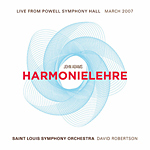This marks the third commercial recording of John Adams’ Harmonielehre–quite remarkable for a classical piece composed as recently as 1985 (Górecki’s popular Symphony No. 3 shares this distinction). Hailed as the “triumph of minimalism”, Harmonielehre is a large-scale orchestral work in three movements that follows the fast-slow-fast pattern of a symphony. Indeed, certain motivic and harmonic links between the first and last movements (for example, the downward woodwind scale that appears before the first movement’s “recapitulation” and also sets up the finale’s coda) do suggest a symphonic construct. The prime mover of the outer movements is an insistent rhythmic pulse (launched by pounding tutti chords at the very opening) that underpins a continuous flow of repeated notes over shifting harmonies. But Adams ventures beyond “pure” minimalism into “neo-romanticism” by incorporating lush melodic fragments married to sweeping gestures. In contrast, the dark central movement “The Amfortas Wound” describes suffering in astringent, angular harmonies, building to a tortured climax.
Performing the piece requires heightened precision and virtuosity on the part of the conductor and orchestra (as a live performance by the New York Philharmonic under Leonard Slatkin clearly demonstrated). These qualities were on full display in the premiere recording by Edo de Waart and the San Francisco Symphony–a performance that set the bar for this work. Simon Rattle’s later recording with the City of Birmingham Symphony for EMI was hampered by rather unimaginative conducting and failed to catch the spirit of the piece.
Which brings us to this new recording by David Robertson and the St. Louis Symphony–the premiere release on the orchestra’s own label. Robertson’s energized reading indicates his love for the work, and the live recording captures the enthusiasm of the St. Louis Symphony players. The brass, particularly the trombones, make a real show of it, but there’s excellent playing from all sections. Robertson makes the first movement’s rhapsodic central section sound especially beautiful, and he really points up Adams’ debt to Sibelius’ Fourth Symphony in the opening of The Amfortas Wound.
The recording is generally first-rate, providing a nice representation of St. Louis’ Powell Symphony Hall. Only the end of the finale is problematic–here the pounding timpani virtually drown out the stirring brass fanfares at the conclusion. Robertson doesn’t quite match the spontaneity and freshness of De Waart’s recording, but it’s a fine version nonetheless. That it’s available only as a digital download (via iTunes and Amazon) may make those curious about this new medium finally take the plunge. [4/8/2008]
































